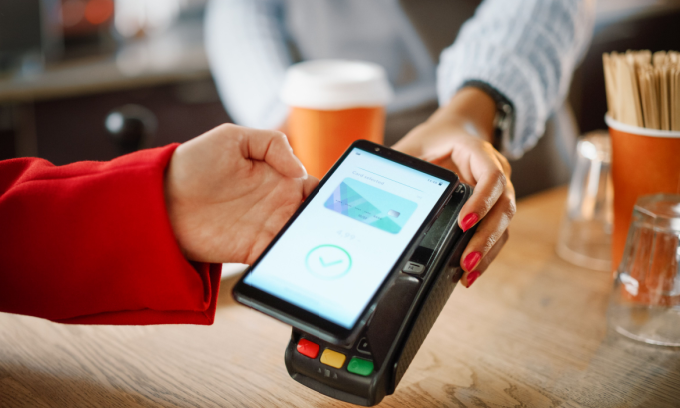How do virtual credit cards work?
Virtual credit cards work much the same way as traditional cards on the surface. Both will normally be linked to a credit card or bank account and have a unique card number, expiry date, and CVV (card verification value). The difference between the two lies in how the card details are stored and how it communicates with vendors and merchants.
Instead of a physical card you carry and swipe, virtual credit cards are ‘stored’ on a device such as your phone, either through your card provider’s app or a digital wallet. But even then, your personal details and card details are not actually stored on the device itself but digitally on the provider’s private network. Instead, encrypted versions of your card details are stored on your device. These are usually randomly generated numbers that are used in place of your actual card when you make purchases.
This means your actual card details are never used or shared with the merchant when making contactless payments. With the encryption and no physical card that can be stolen, virtual credit cards are considered more secure than traditional cards.
Although the encryption normally only applies to contactless in-person payments, more and more online vendors and platforms are offering payment options linked to a digital wallet, such as Apple Pay, Google Pay or Samsung Pay – which can provide another layer of protection when shopping online.
Additionally, there are some virtual credit cards that are instead a single-purpose virtual card number that are only valid for predetermined transactions. These types of virtual credit cards are often used for businesses and have set parameters with limits to where and what it can be used for.
How does contactless payments work?
Contactless payments (or tap-and-go payments), use radio frequency identification (RFID) or near-field communication (NFC) to send encrypted information wirelessly to other devices. You will find RFID technology in your contactless-enabled physical credit and debit cards and NFC technology in digital contactless payments.
In order for NFC to be used, the device is required to be in close proximity to the machine reader for the information to be sent. This adds extra security for contactless payments when used between cards or devices that have NFC capabilities and point-of-sale systems capable of reading NFC data. And in the case of virtual credit cards, an encrypted version of your card details are being used to complete the purchase, which adds another layer of security.
Types of virtual credit cards
As digital versions of the traditional credit card, a virtual credit card could refer to two types of credit cards:
- A true virtual credit card that is void of any physical form and exists solely as a digital card.
- A physical credit card that has the ability to be stored virtually, either on the provider’s own app, or a virtual wallet such as Apple wallet, Google wallet or Samsung wallet.
What are the advantages of a virtual credit card?
Although the extra layer of security offered by virtual credit cards is highly appealing, the biggest advantage would be the convenience and accessibility of your credit card being stored on your phone. Additionally, you could also store your virtual credit card on compatible wearable tech, such as an Apple Watch, Garmin Watch or Fitbit.
In cases where online merchants offer payment through Apple Pay, Google Pay or Samsung Pay at checkout, there’s also the added benefit and security of using the already stored and encrypted card details to complete purchases.
Are virtual credit cards available in Australia?
Yes, many providers in Australia now offer virtual credit cards, but the majority will still provide a physical card. Currently there are only a select few in Australia that provide a purely virtual credit card that has no physical card connected to the account.
In cases where a physical card is provided, the majority of providers still require you to have received your physical credit card before you’re able to access or use it. But some providers, such as Bankwest, Bendigo Bank, CommBank and Westpac, do allow you to activate and access your credit card virtually even before your physical card arrives in your hands. And it’s likely more and more banks and financial institutions will begin to offer this in the near future.
Virtual credit cards are also becoming more widely used by businesses and are offered by a number of financial institutions, including American Express, CommonBank, HSBC and Westpac – as well as smaller providers like Volopay – to their business customers. These types of business and corporate virtual credit cards are normally a single-purpose virtual card number that businesses can impose transaction limits on, including setting spending limits and even particular merchants. And presumably, it puts an end to the days of employees having to hunt around to see who’s got the company credit card.
Which banks offer virtual credit cards to consumers?
Virtual credit card options for Australian consumers have expanded in recent years.
Given the skyrocketing growth and convenience of online shopping, it’s possible more banks will come on board with virtual credit cards in the years ahead. So, it may be a case of ‘watch this space’ to see what’s available in the future.
What are the pros and cons of using a virtual credit card?
For many people, the primary benefit associated with virtual credit cards is convenience and security. On top of avoiding those moments when you can’t find your card, you can also save yourself from typing at checkout for online vendors that offer express payment services. The encryption safety features also mean that you don’t have to worry about a data breach and potentially having your card details stolen.
While virtual credit cards may be potentially safer than a physical credit card, they’re not entirely fraud-proof. You still need to be vigilant with your credit card accounts, and check your card statements regularly to be sure there are no unauthorised transactions. Some virtual wallets and credit card providers also allow for push-notifications when a transaction has occurred, which can be another way to keep on top of fraudulent activities.








